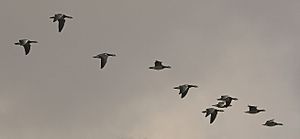From Wikipedia, the free encyclopedia

A flock of Barnacle Geese during autumn migration
[edit] General patterns
Many bird populations migrate long distances along a flyway. The most common pattern involves flying north in the spring to breed in the temperate or Arctic summer and returning in the fall to wintering grounds in warmer regions to the south. Of course, in the Southern Hemisphere the directions are reversed, but there is less land area in the far South to support long-distance migration.The primary motivation for migration appears to be food; for example, some hummingbirds choose not to migrate if fed through the winter. Also, the longer days of the northern summer provide extended time for breeding birds to feed their young. This helps diurnal birds to produce larger clutches than related non-migratory species that remain in the tropics. As the days shorten in autumn, the birds return to warmer regions where the available food supply varies little with the season.
These advantages offset the high stress, physical exertion costs, and other risks of the migration such as predation. Predation can be heightened during migration: the Eleonora's Falcon, which breeds on Mediterranean islands, has a very late breeding season, coordinated with the autumn passage of southbound passerine migrants, which it feeds to its young. A similar strategy is adopted by the Greater Noctule bat, which preys on nocturnal passerine migrants.[3][4][5] The higher concentrations of migrating birds at stopover sites make them prone to parasites and pathogens, which require a heightened immune response.[6]
Within a species not all populations may be migratory; this is known as "partial migration". Partial migration is very common in the southern continents; in Australia, 44% of non-passerine birds and 32% of passerine species are partially migratory.[7] In some species, the population at higher latitudes tends to be migratory and will often winter at lower latitude. The migrating birds bypass the latitudes where other populations may be sedentary, where suitable wintering habitats may already be occupied.
This is an example of leap-frog migration.[8] Many fully-migratory species show leap-frog migration (birds that nest further North spend the winter further South), and many show the alternative, "chain migration" where populations 'slide' more evenly North and South without reversing order.
Within a population, it is common for different ages and/or sexes to have different patterns of timing and distance. Only the female Chaffinches in Scandinavia migrate, with the males staying resident. This has given rise to the latter's specific name of coelebs, a bachelor.
Most migrations begin with the birds starting off in a broad front. Often, this front narrows into one or more preferred routes termed flyways. These routes typically follow mountain ranges or coastlines, sometimes rivers, and may take advantage of updrafts and other wind patterns or avoid geographical barriers such as large stretches of open water. The specific routes may be genetically programmed or learned to varying degrees. The routes taken on forward and return migration are often different.[6] A common pattern in North America is clockwise migration, where birds flying North tend to be further West, and flying South tend to shift Eastwards.
Many, if not most, birds migrate in flocks. For larger birds, flying in flocks reduces the energy cost. Geese in a V-formation may conserve 12–20 % of the energy they would need to fly alone.[9][10] Red Knots Calidris canutus and Dunlins Calidris alpina were found in radar studies to fly 5 km per hour faster in flocks than when they were flying alone.[6]
Birds fly at varying altitudes during migration. An expedition to Mt. Everest found skeletons of Pintail and Black-tailed Godwit at 5000 m (16,400 ft) on the Khumbu Glacier.[11] Bar-headed Geese have been seen flying over the highest peaks of the Himalayas above 8000 m (29000 ft) even when low passes of 3000 m (10000 ft) were nearby.[12] Seabirds fly low over water but gain altitude when crossing land, and the reverse pattern is seen in landbirds.[13][14] However most bird migration is in the range of 150 m (500 ft) to 600 m (2000 ft). Bird-hit aviation records from the United States show most collisions occur below 600 m (2000 ft) and almost none above 1800 m (6000 ft).[15]
Bird migration is not limited to birds that can fly. Most species of penguin migrate by swimming. These routes can cover over 1000 km. Blue Grouse Dendragapus obscurus perform altitudinal migration mostly by walking. Emus in Australia have been observed to undertake long-distance movements on foot during droughts.[6]

No comments:
Post a Comment